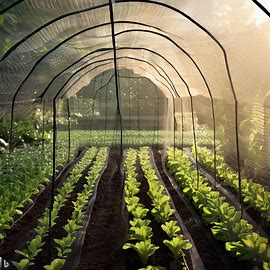Gardening, my friends, isn’t just about watering and weeding. It’s also a test of our crafting skills! Just when you think you’ve got it all figured out, the birds swoop in or the bugs start to feast on your tender plants. But don’t despair! We have an ingenious solution – a garden netting frame!
I know what you’re thinking: “A Garden Netting Frame? How am I supposed to make that?” Fear not! It’s easier than piecing together Ikea furniture – promise! With some simple materials from your local hardware store and a little bit of elbow grease, you can create a fortress for your precious greenies.
So stick around because we’re about to dive into the easy steps of creating your very own garden defender. Let’s get those gloves on and banish those pesky pests once and for all with our kick-ass garden netting frame guide.
Determining the Size and Location of the Garden Netting Frame

When it comes to building a garden netting frame, determining the size and location is crucial.
You want to ensure that your frame is large enough to cover your desired area while also considering any existing structures or plants that may hinder its placement.
Measure out the dimensions of your garden bed or plot, ensuring that you have ample space for both the plants and the frame itself.
Choosing Suitable Materials for the Netting Frame
Selecting suitable materials for your DIY garden netting frame is important in order to build a sturdy structure that will withstand various weather conditions.
One option is using wooden planks as they are durable, readily available, and easy to work with. PVC pipes are another great choice as they provide flexibility while remaining sturdy.
Step-by-Step Instructions for Building a Wooden Frame
Building a wooden frame for your garden netting can be done in just a few simple steps. First, gather all necessary materials including wooden planks, screws or nails, a saw, and measuring tape.
Start by cutting four equal-sized lengths of wood based on your desired measurements for width and length of the frame.
Next, assemble the frame by placing two pieces vertically as uprights and attaching them at each corner with screws or nails. Then attach two horizontal beams across the top edges of these uprights to complete one side of the rectangular structure. Repeat this process on the other side.
Finally, reinforce all corners with additional screws or braces if needed to ensure stability. Your wooden frame should now be ready for attaching netting material.
Selecting Appropriate Netting Material
When selecting netting material for your DIY garden protection frames, there are several factors to consider.
Look for netting that is durable, UV-resistant, and has a mesh size appropriate for the pests you are trying to keep out. Common options include nylon or polyethylene netting.
Attaching The Net to The Wooden Structure
To secure the netting material to your wooden frame, start by draping it over the top of the structure. Gently pull it taut and attach one side of the netting to the frame using staples or zip ties. Continue attaching along each side, ensuring that there are no gaps where pests can enter.
For added security, bury a small portion of excess netting at ground level around the perimeter of your garden bed.
Maintenance Tips and Techniques for Gardening Frames

Maintaining your garden frames is essential to ensure their longevity and effectiveness in protecting your plants.
Regularly check for any signs of damage such as tears or loose attachments and repair them promptly.
Additionally, inspect your garden frames after heavy rain or strong winds as they may have shifted or become dislodged.
Adjustments may be necessary in these situations to maintain optimal protection for your plants.
Implications of Using Garden Netting Frames on Plant Growth

Using garden netting frames comes with certain implications on plant growth that should be taken into consideration.
While these frames protect against pests like birds, rabbits, and insects, they also restrict access to pollinators such as bees and butterflies.
To mitigate this issue, consider hand-pollinating flowers within the protected area using a small brush or cotton swab.
This will help ensure proper pollination despite the presence of a protective barrier.
Conclusion
Building a DIY garden netting frame is an effective way to protect your plants from unwanted pests while promoting healthy growth.
By carefully selecting suitable materials and following step-by-step instructions for construction and maintenance, you can create a sturdy framework that will keep your garden thriving.
Remember to consider the implications on pollination and take appropriate measures for successful plant growth within the protected area. So roll up your sleeves, gather your materials, and get ready to build your very own garden netting frame!

